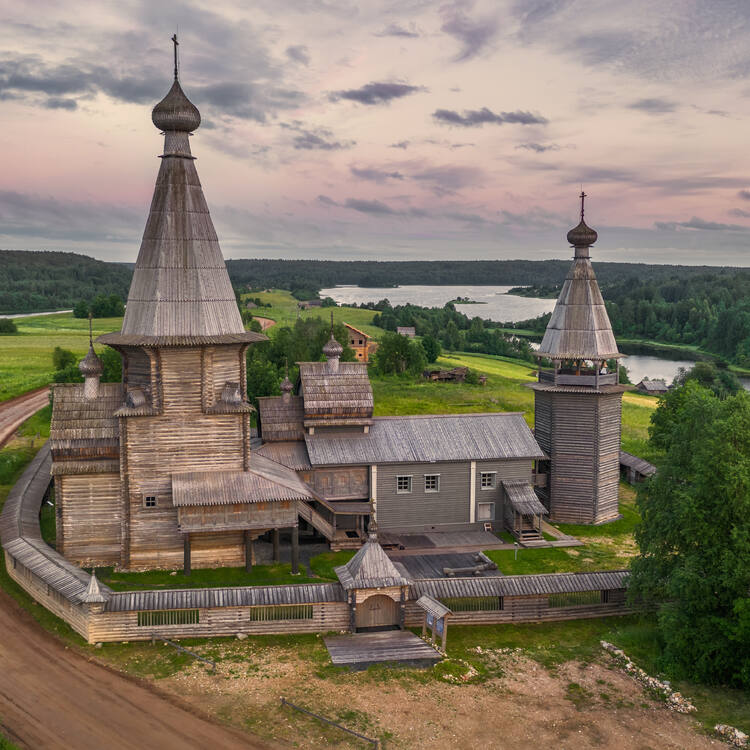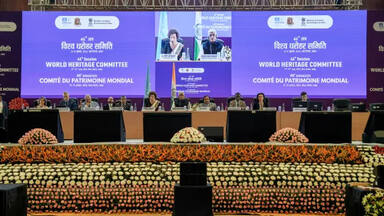Cultural Landscape of Kenozero Lake
Cultural Landscape of Kenozero Lake
Located in Kenozero National Park in the north-western area of the European region of the Russian Federation, the property depicts the local cultural landscape that evolved here from the 12th century, following the gradual Slavic colonization. It incorporates a number of traditional rural settlements with vernacular wooden architecture and reflects the communal management of agriculture and nature that developed when the indigenous Finno-Ugric forest culture merged with the traditional Slavic field culture. Wooden churches and other religious buildings, originally decorated with painted ceilings, or “heavens”, are the key social, cultural, and visual landmarks of the area. Their spatial organization, together with sacred sites and symbols, highlight the residents’ spiritual connection with this environment.
Description is available under license CC-BY-SA IGO 3.0
Paysage culturel du lac Kenozero
Situé dans le parc national de Kenozero, à l’extrême nord de la région européenne de la Fédération de Russie, ce bien illustre le paysage culturel local qui s’y développa à partir du XIIe siècle sous l’influence de la colonisation progressive par les Slaves. Il comprend un grand nombre d’établissements ruraux traditionnels à l’architecture vernaculaire en bois et reflète la gestion communautaire de l’agriculture et de la nature qui se développa lorsque la culture forestière autochtone finno-ougrienne s’associa à la culture traditionnelle slave des champs. Les églises en bois et autres édifices religieux, à l’origine décorés de plafonds peints, ou « cieux », sont les principaux points de repère sociaux, culturels et visuels de la région. Leur organisation spatiale ainsi que les sites sacrés et les symboles soulignent le lien spirituel des habitants avec cet environnement.
Description is available under license CC-BY-SA IGO 3.0
المنظر الطبيعي الثقافي لبحيرة كينوزيرو
يقع هذا الموقع في حديقة كينوزيرو الوطنية في شمال المنطقة الأوروبية من الاتحاد الروسي، وهو يصوِّر المشهد الثقافي المحلي الذي تطور في الموقع منذ القرن الثاني عشر في أعقاب الاستعمار السلافي التدريجي. ويتضمن الموقع عدداً من المستوطنات الريفية التقليدية ذات الطراز المعماري الخشبي المحلي، وهو يجسِّد أسلوب إدارة المجتمع المحلي للزراعة والطبيعة الذي تطور عند اندماج الأسلوب الفنلندي الأوغري الأصلي لزراعة الغابات بالأسلوب السلافي التقليدي لزراعة الحقول. وتتميز هذه المنطقة بمعالم رئيسية اجتماعية وثقافية وبصرية مثل الكنائس الخشبية وغيرها من المباني الدينية التي كانت تزين في الأصل بأسقف مرسومة أو ما يعرف باسم "السموات". وتبرز طريقة تنظيم السكان للمكان إلى جانب المواقع والرموز المقدسة الصِّلات الروحانية التي تربطهم بالمحيط.
source: UNESCO/CPE
Description is available under license CC-BY-SA IGO 3.0
克诺泽罗湖区历史见证
该遗产地位于欧洲俄罗斯西北部的克诺泽罗(Kenozero)国家公园内,展现了12世纪以来当地逐渐被斯拉夫人殖民后形成的文化景观。这里有许多传统的乡村民居和乡土木质建筑,反映了芬兰—乌戈尔森林原住民文化和传统斯拉夫田野文化融合产生的农业与自然协同管理模式。木质教堂等宗教建筑是该地区重要的社会、文化、景观地标,最初安装有被称作“天堂”的彩绘天花板。这些建筑的空间构成结合其他宗教遗存和象征标志,共同突出了居民与环境的精神联结。
source: UNESCO/CPE
Description is available under license CC-BY-SA IGO 3.0
Культурный ландшафт Кенозерья
Объект расположен в Кенозерском национальном парке на северо-западе европейской части Российской Федерации. В нем сохранился местный культурный ландшафт, который формировался с XII века в результате постепенной славянской колонизации. Здесь расположено несколько традиционных сельских поселений с самобытными памятниками русского деревянного зодчества. В них отражены особенности общинного землевладения и природопользования, сложившиеся в результате слияния традиций коренного финно-угорского лесоводства и славянских традиций полеводства. Ключевыми социальными, культурными и визуальными достопримечательностями района являются деревянные церкви и другие культовые здания, которые изначально украшались расписными потолками или «небесами». Духовную связь жителей с окружающей средой подчеркивает пространственная организация парка, а также наличие священных мест и символов.
source: UNESCO/CPE
Description is available under license CC-BY-SA IGO 3.0
Paisaje cultural del lago Kenozero
El sitio está situado en el Parque Nacional Kenozero, en la zona noroccidental de la región europea de la Federación de Rusia, y representa el paisaje cultural local que evolucionó en esta zona a partir del siglo XII, tras la colonización gradual de los eslavos. El bien comprende una serie de asentamientos rurales tradicionales que presentan una arquitectura vernácula de madera. Además, refleja la gestión comunal de la agricultura y la naturaleza que se desarrolló cuando la cultura forestal autóctona ugrofinesa se fusionó con la cultura agrícola eslava tradicional. Las iglesias de madera y otros edificios religiosos, originalmente decorados con techos pintados o "cielos", constituyen los puntos de referencia clave sociales, culturales y visuales de la zona. Su organización espacial, junto con los lugares y símbolos sagrados, ponen de relieve la conexión espiritual de los residentes con este entorno.
source: UNESCO/CPE
Description is available under license CC-BY-SA IGO 3.0
Outstanding Universal Value
Brief synthesis
Located in Kenozero National Park in the north-western area of the European region of the Russian Federation, the picturesque Kenozero relict cultural landscape depicts the peasant lifestyle that evolved here from the 12th century, following the gradual Slavic colonisation of the region. It incorporates a large number of traditional rural settlements with vernacular wooden architecture set in an evocative landscape of lakes, rivers, forests, and fields that preserve traces of past traditional practices. Wooden churches, churchyards and chapels, many of which were originally decorated with painted ceilings, or “heavens”, are the key social, cultural, and visual landmarks of the area. The spatial organisation of these buildings, together with sacred groves, cemeteries, and wooden crosses dotting the landscape, bear witness to the spiritual connection of the inhabitants to this environment.
Criterion (iii): The exceptional collection of historic wooden buildings of Kenozero Lake, in all their rich diversity of types and uses, is an important representation of the cultural traditions of this region. Traditional woodworking and log construction bear witness to the evolution of early log structures into a sophisticated assembly of domestic and religious buildings. Historic rural settlement patterns and evidence of the use of natural resources in a scenic lake-river landscape are likewise a testimony to a cultural tradition in the Russian North.
Integrity
The boundaries of the property contain all the key attributes necessary to convey its Outstanding Universal Value. A substantial number of traditional wooden buildings have been preserved in their authentic locations and settings within the property. Of the seventy-seven settlements that existed in the early 20th century, sixty-two have been fully preserved, containing 1,520 traditional religious and domestic wooden structures.
Authenticity
The property is authentic in terms of the preserved wooden architectural elements, the patterns of the settlements, and the setting. The monuments of wooden architecture have been preserved with respect for the authenticity of their materials, form, and design. The form and layout of fields and lakeshores around inhabited villages are also maintained. Despite modernisation and several restructurings of agriculture and production in the 20th century, the spirit and feeling of the cultural landscape remain complemented by surviving intangible heritage and traditional practices supported by the management of the property.
Protection and management requirements
The property is protected by several legal mechanisms at the national and regional levels. There is comprehensive legal protection from both cultural and natural sectoral perspectives. Kenozero National Park was established in 1991, and a 500-metre-wide protection zone was delineated in 1995 as an additional protection of the National Park. The protection zone is intended to ensure the preservation of the natural areas, the economic use of which directly affects the biological stability of ecosystems and the Kenozero cultural landscape, and to prevent potential adverse impacts by anthropogenic processes.
Kenozero National Park is the main management authority. The administration of the National Park includes local community members as well as professionals from the region. There are several national, regional, and local strategies in place to support sustainable development. Kenozero National Park oversees all issues regarding the property in coordination with the relevant sectoral institutions as well as local authorities of the respective municipalities.
The management plan of the property and its buffer zone covers the period 2021-2027 and is in the process of implementation. It introduces a unified approach to the management of the National Park, UNESCO Biosphere Reserve, and the property. The plan includes strategies for all these three different domains, integrating conservation and sustainable development within a holistic approach. The protection of the Outstanding Universal Value of the property is the basis for the entire strategic planning process. The management plans for all cultural landscape complexes should be developed. The local communities are recognised as having a special role amongst the stakeholders.

